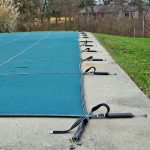ANATOMY OF YOUR POOL SYSTEM – CIRCULATION & FILTRATION
Not every pool is the same, but every pool does have some of the same parts. Do you know what the parts of your system do for your pool? Every pool will surely have a pump and filter. Heaters and chemical feeders are not on every pool, but both nice to have! We understand that you may not know what the different parts of your pool system are called, but we want you to be versed so when you call us in to tell us there is a problem we can get an idea of what is happening.
EVERYBODY PUMPS
Every pool is going to have a pump, and maybe multiple pumps. The pump is the heart of the pool system which provides the motion of the water through the filtration system. The common misconception is that pumps suck the water in. Although the side prior to the pump is called the suction side, gravity is moving the water toward the vacuum that the pump creates. This force then moves the water from the pump exiting through the pressure side or discharge where the water will continue to move through the rest of the system. Your pool may have additional pumps for a spa, vacuum, or waterfall, that operate in the same way.
CAUTION I HAVE NO FILTER
This is not what a pool system would say, as a filter is needed as the part that cleans the water by removing the contaminants. When the water leaves the pump, it is going to the filter. The types of filter and their media include the sand filter using sand (or an alternative), a diatomaceous earth (D.E.) using D.E. (or an alternative), or a cartridge filter using cartridges. What type of filter you have was probably decided upon based on preference, availability, or the type your installer had. Regardless, all filters mechanically clean the water in an effort to remove contaminants and suspended particles.
HOW LOW CAN YOU FLOW
The water that flows through your system is flowing through piping. There are multiple types of piping including flex, poly, and PVC. PVC is the hard plastic type piping which is recommended as it does not succumb to pest rot and UV degradation as flex and poly piping would. PVC piping should be used for all underground pipe work. Your pipe size is based upon the size of the pool. Most residential pools have pipe size of about 1 ½ inches. It is best for your system to have as few angles or turns as possible, as that can slow down your flow.
WHICH WAY DID HE GO
You may also have valves on your system. Valves control or regulate the flow of the water in your system. They can be operated manually or you may have automated ones. Valves can be used to isolate suction and flow (i.e., for vacuuming), bypass certain components in your system (i.e., in case you want to bypass your heater), control operation of your filter (i.e., changing modes of operation), and preventing backflow (i.e., having chemically treated water flow back into your heater).
SO NOW YOU KNOW
Pumps, filters, piping, and valves are the most basic parts of a pool system. This introductory will help you to understand the parts and what exactly it is they are doing. So now when something goes wrong, you will be able to let us know what it is!






